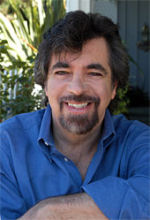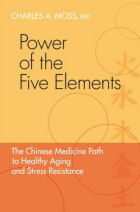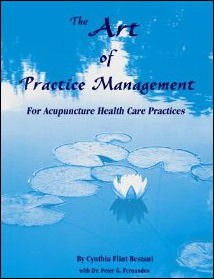Acupuncture & TCM Articles

Neil R. Gumenick is the founder and Director of The Institute of Classical Five-Element Acupuncture. Neil is a Worsley certified advanced teacher of Classical Five-Element Acupuncture and a practitioner with over 27 years of private practice experience. Neil holds three degrees from the College of Traditional Acupuncture (U.K.), and he participated for 10 years in the Master Apprentice Programô, led by Profs. J.R. & J.B. Worsley. Neil has taught at the USC and UCLA Schools of Medicine, the Worsley Institute of Classical Acupuncture, the Traditional Acupuncture Foundation, California Acupuncture College, Santa Barbara College of Oriental Medicine, and Pacific College of Oriental Medicine. He has been a Professor at Emperor's College of Traditional Oriental Medicine and SAMRA University of Oriental Medicine. Neil is co-author of The Art of Practice Management for Acupuncture Health Care Practices
The Initial Consultation: Getting to the Heart of the Matter, Part 1
By Neil Gumenick, MAc (UK), LAc, Dipl. Ac
In classical Five-Element acupuncture, the goal of the traditional diagnosis is to identify the primary elemental imbalance (causative factor) of the patient's disease and the level of the imbalance: physical, mental or spiritual.
The initial consultation (also called the "traditional diagnosis") is an opportunity for the practitioner to bring all diagnostic skills into play: seeing, asking, hearing, feeling and smelling.
It is not enough, however, to know what element or organ/function to treat. In order to know precisely what points to treat, we must determine the unique and specific needs of the individual patient before us. To do this, we must skillfully examine the patient and reach beneath the superficial level of response to the deeper issues that must be addressed. Remember that patients, like all of us, wear "masks" and often do not openly reveal their true feelings. Gaining the patient's trust is of the utmost importance, and the vital skills of rapport lead to the creation of that trust.
Questioning Beneath the Superficial Layers
 
In the initial consultation, we inquire into many aspects of a patient's life, any or all of which can reveal a wealth of information about who the patient is and what he or she needs in order to be helped toward balance and harmony. As an example, in asking a patient's occupation, the mere fact of a person having a specific occupation tells us relatively little. Discovering who that individual is in relation to that job tells us a great deal.
We know that people have strong feelings about their jobs - positive or negative, but rarely neutral. Work is a primary identity for most people, taking up most of their waking time. Thus, if a patient is a taxi driver, for example, we are led by curiosity to ask further and question more deeply about it. We might ask how they enjoy the job. One taxi driver might simply love the job - meeting people, conversation, or always being on the move. Another might love the independence it provides. Another might be doing the job as a last-ditch effort to make ends meet - perhaps having been laid off from a former, more lucrative or prestigious job, perhaps frustrated and resentful, fearful, depressed or resigned.
Who the patient is in relation to their job (or any area of inquiry), is what fascinates us and conveys what the person needs. What does this person get from the job? Why do they do it? What needs does it fulfill, or not? Thus, we use questioning as a means of going deeper into a patient's experience, until we get to the "heart of the matter."
Not all areas of inquiry will be equally or entirely fruitful. If there is no emotional charge or challenge in an area, we move on to another. When we are presented with an "opening" that strikes our curiosity, we have an opportunity to venture inside. An area of a patient's life that holds emotional charge is neither good nor bad, but merely indicates a place where balancing may be needed.
Here, we must also consider if the expressed emotion is appropriate to the situation. Nature has provided us with five emotions - joy, sympathy, grief, fear and anger - which are all normal and healthy expressions in a given set of circumstances. When we perceive a patient's emotion to be inappropriate, either by its excess or deficiency, we view it as a cry for help and of great significance diagnostically.
Determining Appropriateness
How do we determine appropriateness? In a context in which we would normally expect a certain emotion, the expression feels normal; it does not strike us as inappropriate. It is a natural response, and we will not feel it as jarring or discordant. For example, the expression of anger and the sound of shouting in a frustrating situation would be appropriate. However, a continual expression of anger and frustration, having a "bossing" quality to the voice (which we label "shouting"), regardless of the context, or conversely, a lack of anger and shouting when we would expect it, does point to an energetic imbalance. Thus, we would have two of four diagnostic indicators (sound and emotion - the others being odor and color) pointing to the wood element. According to the teachings of classical Five-Element acupuncture, if we perceive three of the four diagnostic indicators pointing to one element, the causative factor is confirmed. Thus, if we also sensed the odor of the patient as rancid or the skin color lateral to the eyes as green, we would know that wood was the source of the patient's imbalance, regardless of their presenting symptoms.
This system of medicine asserts that every human is born with, or develops in the formative years of life, an imbalance or propensity to imbalance in one of the five elements and its associated officials (organs/functions). This is the causative factor and is the source of the myriad symptoms one develops over a lifetime, including immunity to disease and the ability to heal. Any symptom can come from imbalance originating in any of the five elements. The imbalance of the causative factor element will spread throughout the entire system, resulting in the imbalance of all other elements and officials. Thus, symptoms can and will appear anywhere. We must determine and treat the cause to assist nature to truly cure the imbalance.
A Case Study
I recall a patient who was very angry in regard to his business affairs. He was losing money month after month and saw no way out of the situation. When the interview turned to the subject of his children, about which I expected to get some feelings of warmth and joy, I was surprised to feel the same level of anger and frustration. On the subject of his presenting physical complaint, about which I expected to find some measure of fear or concern, there again was his anger. He was so deeply immersed in his "problems" that he could see no way out. Although I presented him with choices and options to consider, everything still seemed an irritant and a source of further anger. His spirit was strong, in the sense that he possessed vast amounts of energy to continue the "fight," but needed a respite - a relief. In addition to his shouting voice and excess anger, he also smelled rancid and showed a green color lateral to his eyes. His causative factor was wood.
Among the points I used was Liver 5, translated from the Chinese characters as "Insect Ditch" and Gall Bladder 40, translated as "Wilderness Mound." I illustrate these points, not as formulas for anger or wood-imbalanced patients, but in response to the specific needs of this individual patient. Virtually all of the points on the wood meridians have a unique spiritual connotation and gift to offer when needed. It is our job to sense the need.
Liver 5, "Insect Ditch," is a point that can clear away irritation of the mind and spirit. This patient was plagued, as if by insects. The metaphor of insects here refers to irritating thoughts, agitation, constant "itching" and "inflammation" at the mental and spiritual levels, confusion and toxicity. The point clears the "insects" and removes them to the "ditch," leaving the patient relieved, calmed, subdued, at peace and in control, with the ability to see more clearly.
Gall Bladder 40, "Wilderness Mound," enables the wood-imbalanced patient to see beyond the "wilderness," fraught with confusion, desolation, and a sense of being lost and overwhelmed. A mound is a high place from which one can see from a high perspective, with the eyes of spirit. Mounds were traditionally burial places, containing the bones of the ancestors. Thus, standing on such a mound, one has the benefit of the collected wisdom of the elders - those who have seen it and done it all - who are able to share their vast, rich experience. What a relief to one who is lost and alone in the wilderness to be able, at last, to put one's life into perspective and begin to make healthy decisions and deal with problems, rather than endlessly obsess over them.
Thus, the choice of points, used for their spiritual connotations, is a response to the need of the patient. The Chinese, in their brilliance, determined the physical, mental and spiritual gifts each point is capable of providing. The point names, translated from the Chinese characters, in conjunction with pulse diagnosis, accurate diagnosis of the causative factor and the removal of specific energetic blocks, can and do provide the needed help for virtually every challenge a human can face.
 
The Art of Practice Management for Acupuncture Health Care Practices
What you will find in this book is a specific, comprehensive approach that gets to the root cause of success in practice.
This new book presents acupuncture practice as art from the standpoint of centering, qi, and wholeness. It builds on the premise that practices succeed from bridging inner and outer aspects of the self. It is an inquiry into the self and addresses clear understandings and approaches to reputable patient care and practice qi. It brings in the five elements and work with the seasons of practice from training and start-up to growth, stability, expansion and transformation. The authors artfully bridges the essence of both patient and practitioner well-being without excluding the practicalities of financial well-being. This book very specifically and extensively shows how the different parts of practice nourish and feed one another and are interdependent on one another for the qi to flow synchronistically.
It explores the dual nature of procedures that work and those which do not in acupuncture health care practice, returning again and again to the delicate balance of practicality and spirituality.
|
